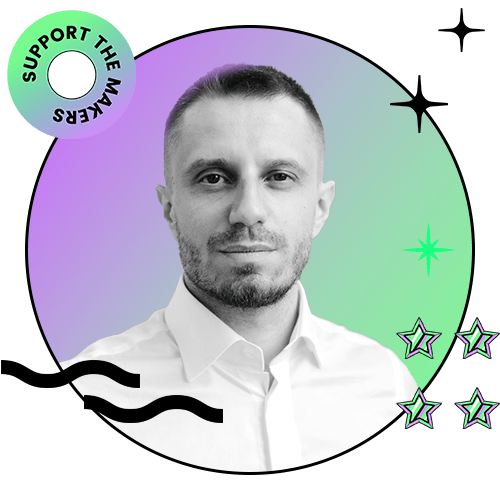 Back to blog
Back to blog
Let’s launch a project the Develtio way

Launching a new software development project is no small feat by any means. It requires a lot of planning, effective communication between stakeholders, and a skilled Project Manager able to ensure all boxes are ticked, and no stones are left unturned. At Develtio, we know how vital a (un)successful launch can become to a project’s outcome. Read on to learn about our process and what we do to safely navigate the stormy seas of software project management.
Kick it off with a style
Once the binding contract is signed, your freshly designated PM reaches out to the sales analyst to gather as much information about you (The Client) and the project as possible. The Project Manager uses the data to prepare a list of issues to be discussed during the Kick-off meeting.
Simultaneously, he (or she) starts drafting an outline of the product’s structure. It can be used as a template for the final project, especially if no unusual custom features are needed.
And then the big day comes, and the parties get together for the first time. The scope of the kick-off meeting stretches far beyond an opportunity to meet the people involved in the project. For you, the Client, it’s a chance to familiarize yourself with our method and look into the next steps in the process. For us, it’s primarily about listening to you and getting a deeper insight into your vision.
The kick-off meeting is a crucial part of the project launch at Develtio – see here if you want to learn more about it.
Busy, busier, PM
Once the kick-off meeting is done and dusted, it’s all in the hands of the busiest of bees – often referred to as the Project Manager. There are plenty of tasks PM has to attend to at this stage, and each has to be sorted out as soon as possible:
- JIRA – no serious software development project can be successfully completed without the aid of a work management tool. At Develtio, we use JIRA, the market-leading solution for managing workflows. The first thing the Project Manager does after the kick-off meeting is setting up the project’s structure in JIRA, which is used to distribute relevant tasks among teams involved in the project.
- PROJECT ROADMAP – when the tasks are properly set up in Jira, it’s time for the Project Manager to prepare a roadmap. It’s a high-level graphical schedule that outlines what will be done and when. The roadmap illustrates the main goals for the project and the milestones needed to achieve them. It isn’t very detailed, as it doesn’t need to be. Its primary purpose is to give the stakeholders a single point of reference to the project’s strategic goals and a brief overview of the current state of the project’s completion.
- MEETINGS – scheduling frequent and regular meetings between the project stakeholders is crucial to maintaining the smooth flow of information and keeping the highest possible level of transparency. Meetings with the Client are set up in line with planned sprints (where applicable), so the information on completed milestones or encountered roadblocks is relayed without unnecessary delays.
- TOOLS ACCESS – at this stage, the PM ensures that all stakeholders (including the Client) have access to project-relevant tools, e.g., Confluence for project documentation, Bitwarden for secure password management, etc. Please note that the tools required may differ between the projects, but access is always granted with the project’s transparency in mind.
that you can change
your business.

And the backlog keeps on growing
Every project needs a detailed and structured list of deliverables required for completion. The list is called a backlog, and its structure is heavily affected by the methodology chosen prior to the project launch. There are two main approaches we use at Develtio:
The waterfall – is a traditional, linear methodology adopted when the project contains well-described deliverables and concrete timelines. With the waterfall approach, the Project Manager defines all required software features (called User Stories) upfront. The backlog created in the waterfall methodology contains all the functionalities identified at the beginning of the project and seldom gets modified throughout.
Agile – it’s an iterative methodology allowing to plan development in stages, used best when the complete scope of the project isn’t fully defined. The backlog for projects developed with the Agile approach changes and grows constantly – initially, the PM adds only known user stories and extends the backlog when needed.
Time for a Product Board
We’ve already made it far, but our project is still missing one crucial element – a Product Board. It contains a comprehensive set of essential project information and is used as a point of reference for:
- Personnel involved in the project
- Tasks planned for specific teams
- Main project goals
- Project personas (user and admin profiles)
- Risk matrix
Once the Product Board is drafted, the PM calls a planning meeting with the Client, where the product’s lifecycle and short-term goals are discussed. The meeting is also used to exchange information on stakeholders’ availability (holiday leaves, unplanned absences, etc.)
Also, somewhere in between, the Project Manager calls another meeting exclusively with the development team. Its purpose is to build a risk matrix that will be incorporated into the Product Board.
3, 2, 1 Launch!
A well-established and thought-out process, led by a skilled Project Manager, can make a world of difference to the launch and eventually the outcome of a software development project. At Develtio, we have hundreds of successful project launches under our belt. And we would love to add yours to the collection. Get in touch with our representative, and let’s discuss your dream project.
Similar posts:
What can we do for you?
Talk to us about your project and let's start building it together!







